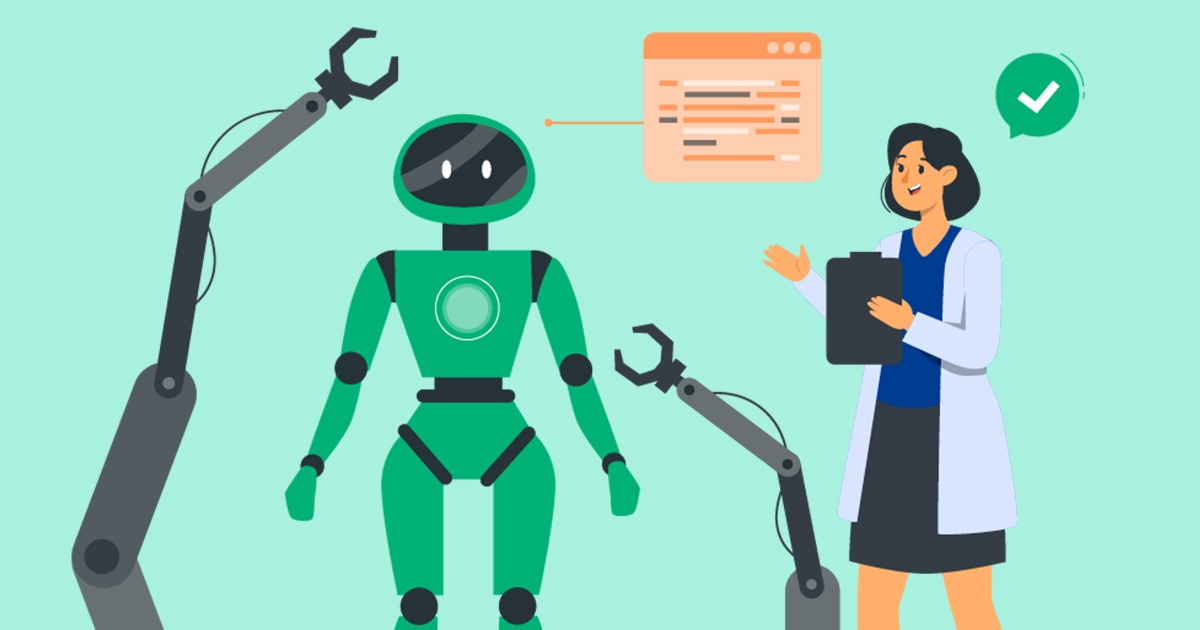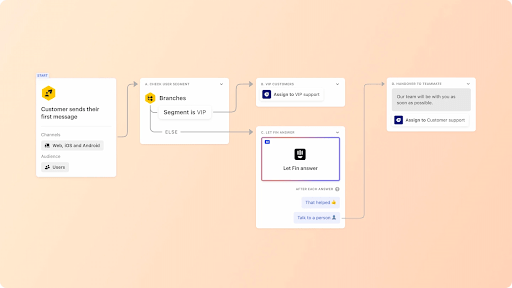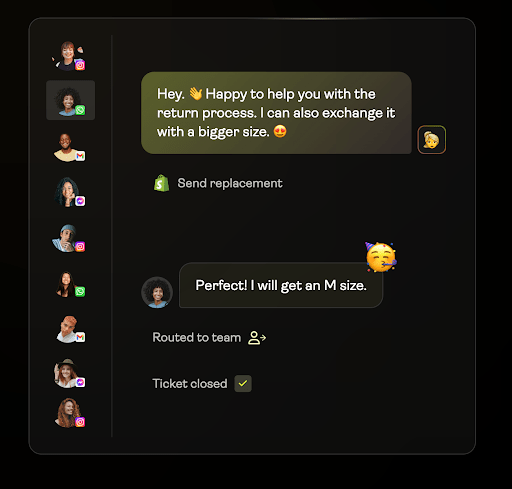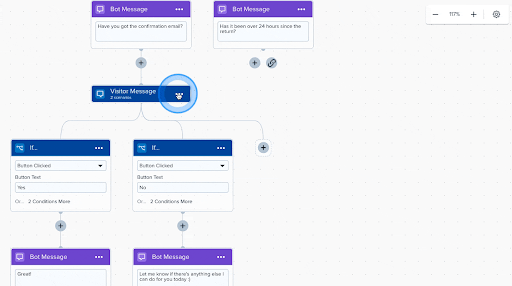Expert Guide to Choosing a Generative AI Platform

Introduction
Generative AI has kickstarted a seismic shift in customer service. And while getting generative AI right can transform your support team, getting it wrong leads to a ton of wasted time, effort, and money.
If you’re nervous about implementing generative AI in your business or you’re feeling overwhelmed at the number of generative AI platforms out there, this guide will walk you through what to consider and which tools you should give a closer look.
What are the benefits of generative AI in customer support?
Technology has always been part of providing great customer service. For most CX problems, you have two default options: throw more people at it, or implement better tools and processes.
At its core, generative AI in customer support conversations involves the use of large language models (LLMs) to generate conversational and human-like responses, offering real-time assistance to customer inquiries. These tools and platforms are a major leap forward from the chatbots that many companies have relied on for the past decade, unlocking a new level of efficiency in customer service and a more personalized and engaging experience for the users.
Many of us have experienced needing to hire more agents as a short-term fix. That’s because historically new technology has always come with high costs, long implementation timelines, and steep learning curves for your team.
But that’s all changing with generative AI, which can be implemented and have an impact in a matter of weeks. BCG estimates that generative AI can increase productivity by 30% to 50% — or possibly even more. It’s why AI solutions are one of the most exciting opportunities in the customer service space right now.
Generative AI is being used across the customer journey, both in “front of stage” interactions with customers (like AI chatbots, the focus of this post) and in “back of stage” areas like training support agents, workforce management, and quality assurance. While it’s still the early days of this revolution, some experts are predicting that 100% of customer interactions will be enabled by AI in the coming years.
Zeroing in on customer-facing applications, here are the top three benefits customer support teams are seeing from AI right now.
Faster response times
AI is fast. With an AI tool at the forefront of your customer service team, you have an always available and scalable frontline. An unexpected spike won’t overwhelm AI, and they never have to take a moment to step away to use the bathroom or grab a coffee (at least, not yet).
That means no matter the time of day, your customer can get near-instant answers to their questions.
Increased accuracy
Properly configured AI tools are much less likely to make mistakes than human agents. That’s because every time you hire a new agent there’s a long period of training and ramping them up, whereas AI simply remembers.
Now, to be fair, implementing and training an AI isn’t always easy — people make all kinds of mistakes when implementing AI.
But because generative AI is so much better at understanding intents and providing accurate responses, you’ll see far better results than with earlier chatbot solutions whose answers are either hard-coded or seem more like guesses.
Personalized experiences
Generative AI has the ability to create tailored and bespoke experiences that feel natural to customers.
This is a huge improvement over previous tools — and support leaders are recognizing it. Zendesk’s 2024 CX trends found that 65% of CX leaders believe their AI is becoming far more natural and creating more personalized, human-like experiences.
Generative AI speed dating: introducing some of the best AI platforms for customer support
Good choice for Zendesk customers
Zendesk, founded in 2007, is one of the biggest players in the customer service industry. While it’s been around for awhile, Zendesk is still working hard to maintain a grip on the cutting edge of customer support technology.
In 2023, Zendesk enhanced their existing AI offering with generative AI powered by OpenAI. This new offering takes its conversational bots and agent tools to the next level.
The foundational feature of Zendesk’s AI is their conversational bots, which are trained on your Zendesk Guide content.
Zendesk bots can provide human-like summaries of your help content as solutions to your customer requests. This is on top of its existing powerful automation features, which enable teams to build complex predefined self-service solutions and routing — all within the customer’s chat experience.
Unique to the new generative AI conversation bots is the ability to give your bot representative a specific persona and tone – from serious to casual – to match your company’s support voice.
Zendesk has also applied the powers of generative AI to the agent experience. Your support agents can now use AI to quickly summarize existing customer conversations, expand drafted email responses into detailed replies, or to shift their writing tone to be more friendly or formal for specific interactions.
Good for Support Teams on a budget
A relatively new player in the space, CaffeinatedCX offers a suite of generative AI-powered tools at a price point that’ll make your CFO happy (yes, for real).
What sets Caffeinated CX apart from other AI solutions is its emphasis on empowering your team — not replacing it. Founded by a customer experience leader, this tool offers fantastic value for price conscious teams.
Caffeinated CX offers a generative AI chatbot which can lead to a significant uptick in your self-service rate and ticket deflection. It can integrate with popular platforms like Zendesk, Intercom, Salesforce, Zoho and Freshdesk, meaning it can help regardless of which ticketing platform you use.
Caffeinated CX’s chatbot is backed up by a wide selection of agent empowerment tools, including content tone training, one-click “reply & close” tickets that suggest solutions to human agents, and AI-powered macro suggestions.
To top it off, they promise a 57-second installation – which might be the fastest we’ve ever seen before.
Good for Intercom power users
Fin, released in 2023, is the friendly name for Intercom’s AI tool. Powered by OpenAI, Fin centers around a natural language chatbot capable of asking clarifying questions and tackling simple to complex issues in a human-like manner.
One of the major advantages of Fin is its tight integration with the broader Intercom experience, which is why it’s a great add-on for teams already invested in the Intercom ecosystem. Fin works with Intercom’s inbox, ticketing, messenger, reporting, and more — without any additional setup.
For teams looking to create truly seamless customer support, Fin’s integration with Intercom’s workflow functionality can be powerful. Intercom workflows allow you to get super granular with how different customer interactions get handled — such as passing customers directly to VIP support if they’re on a certain package or viewing a certain page, while letting Fin jump in to handle other conversations.

Fin also supports hand-offs to Zendesk or Freshdesk if you’re not a current Intercom user.
The Fin chatbot is capable of learning from a wide variety of your support knowledge base, including your Intercom or Zendesk help centers, public URLs, and conversational snippets. They’re even looking to support your historical conversations as a source of training content in the near future!
Good for high volume organizations and phone support
Founded in 2016, Ada is one of the early and most successful players in the AI-powered chatbot space — Ada’s 6x’d their revenue in just a three year span. Ada is a prominent choice for larger companies with high volume organizations with the potential to see enormous returns on the efficiency gains Ada provides.
Ada’s AI agents are trained on a wide variety of your customer data sources – like your help center, CRM, and even order management system. By harnessing the power of OpenAI’s, Ada is able to engage in human-like reasoning to solve multi-step and complex problems.
Ada is also one of the only tools on this list that harnesses generative AI to improve your phone support. Ada’s voice automation learns from the same data sources, then transforms your IVR by recognizing what your customers want — even when they talk using natural language, not forced options. Its no-code builder allows you to map out specific process flows for different phone scenarios, including things like authenticating users, preferred call routing, and more.
Ada includes integrations with support platforms like Zendesk, Intercom, Gorgias and Kustomer, plus CRMs like HubSpot, Marketo, and Salesforce. You can even connect directly to scheduling tools like Calendly!
Good for ecommerce companies
When you’re an ecommerce company, creating meaningful connections between customers and your brand is paramount. Leveraging AI to create those connections may seem counterintuitive, but there’s a reason Siena bills itself as “the world’s most human-like AI.”
Siena operates like a virtual agent, interacting with your customers and prospects across channels like Whatsapp, Instagram, your website, and email. Unlike traditional rules-based chatbots, Siena is capable of handling multiple customer intents and completing complex tasks — meaning it’ll actually help your customers resolve issues, not just deflect those conversations away from your support team.

Since Siena is focused on ecommerce use cases, it integrates with the big players in the ecommerce ecosystem, like Shopify, Gorgias, and Recharge Payments. It’s an incredibly effective way to scale up your ecommerce support in a personalized way, without needing to hire dozens of agents every holiday season.
Good for large teams who want a flexible solution
Founded in 2016, Ultimate offers a suite of AI-products including Ultimate, an enterprise-focused AI platform, and its more entry-level conversational chatbot, UltimateGPT, which is powered by OpenAI’s latest GPT-4 model.
Designed with scaling in mind, Ultimate’s AI platform can bring massive improvements to your support organization’s efficiency.
Ultimate analyzes previous support conversations to identify your most common questions, creating a chatbot that’s trained on your specific customer requests. Ultimate claims some customers have seen this solution automate as much as 60% of your customer service — likely in industries with a high volume of repetitive requests, such as ecommerce.

Ultimate’s no-code Dialogue Builder is visual and intuitive, making it easy to map out specific processes and automations. It’s also able to pull in customer details from your CRM, enriching your ability to make decisions and personalize the AI-powered experience.
UltimateGPT, their chatbot for smaller teams, offers a natural, human-like experience in 109 languages. Just like some of the others on this list, UltimateGPT’s persona can be tailored to your brand’s specific voice and tone. It also included high-level analytics and conversation transcripts, helping you to understand where you can improve.
Ultimate is fairly platform-agnostic, able to connect seamlessly into your existing tech stack through integrations with popular support platforms like Zendesk, Freshworks, Intercom, and Salesforces and extensible frameworks like Sunshine Conversations.
Good for companies with a high volume of phone interactions
Floatbot is a no-code, AI-powered conversational AI platform that enables companies to build chatbot, agent assist bots, and, most notably, voicebots. Floatbot is probably best known for their voicebots, which can do everything from outbound cold-calling for your sales team to transforming your IVR to using voice biometrics to improve security and authenticate customers.
Floatbot’s voicebots can easily scale up with your phone volume. Because they leverage generative AI, they create a far more interactive and personalized experience than a traditional phone tree or IVR. And since Floatbot integrates with many of the largest contact center tools on the market, including Avaya, Cisco, Genesys, and more, it also enables intelligent and easy handoffs to a human support agent whenever needed.
With the ability to conduct human-like conversations across 150 different languages, Floatbot can change how you interact with customers across the globe.
Good for
Forethought is a generative AI platform that aims to impact every area of your customer experience. By identifying customer sentiment in real-time and triaging and routing tickets, Forethought’s platform ensures customers get the help they need quickly.
Forethought also includes Solve, which uses your historical ticket data to automatically interact with and resolve customer issues — across multiple different channels. The included no-code workflow builder allows you to automate actions and integrate them across different channels and tools, while Forethought’s Assist product helps your support agents find the information they need, right when they need it.
Last, but certainly not least, Forethought includes an insights and analytics engine, which uses generative AI to uncover insights and provide actionable recommendations on how you can improve your customer experience.
What to know before you get started with generative AI
The success of your generative AI implementation hinges on the upfront effort and planning you put into the process. While many generative AI platforms are relatively easy to connect to your help desk, you’ll only see meaningful ROI if you start by defining your organization’s specific needs, circumstances, and goals.
Determine your specific goals and needs
Teams who are set aside the time to clearly determine their goals and needs are best equipped for success with AI-powered solutions.
A good starting point is asking these essential questions:
- What issues and obstacles are you aiming to solve with your AI implementation?
- What outcomes do you want to achieve with your AI implementation?
- What metrics will you use to evaluate success towards those objectives?
- What resources do you have or need to implement your solution (like engineering help, AI expertise, etc.)
With all of these questions, keep in mind that your answers may be customer-focused (e.g. reducing long hold times) or team-focused (like reducing ticket volume so your team doesn’t burn out).
Do these five things BEFORE implementing AI
We’ve written full posts on the mistakes businesses make when implementing AI, but here’s a summary of things to keep in mind when you’re choosing your generative AI platform.
Optimize your existing resources first
Bringing AI into a disorganized system isn’t going to help you solve customers’ problems. It’s going to give you another system that needs to be managed, which might actually make things worse. Your AI tooling requires the support of other important resources — like your knowledge base and CRM — and will work within the constraints of others, like your support ticketing software.
Spend some time optimizing your existing resources and tools before investing heavily into AI-powered solutions.
Leverage existing automations
Automation is a high leverage investment and it’s likely that many of your existing tools have powerful automation features already.
Before cutting a check for a new tool that makes big promises, make sure you’re maxing out the potential of your existing tools. Partnering with an experienced AI solutions provider can be helpful here, as their wide range of experience implementing and optimizing AI systems can accelerate your results.
Integrate AI into the entire customer journey
Tacking on a generative AI chatbot to the front of your customer journey and not adapting the rest of the journey is a common failure point.
It’s an understandable mistake, because when an AI tool is offering to deflect 60% of your tickets or to automate 50% of your team’s work, it’s tempting (to say the least). But throwing a chatbot onto your website won’t produce the results you’re looking for — you need to make time to reevaluate your existing workflows and processes as well.
Recognize that implementing AI is an ongoing journey (not a quick fix)
Implementing AI is not a one-and-done proposition. You need to manage your AI like you manage a human agent. Measure metrics like customer satisfaction, quality assurance, and first contact resolution – the same metrics you measure for people. When your bot fails to meet your KPIs, look deeper to understand why and fix the problem.
This ebook on key performance indicators for customer service includes examples of metrics you can use to gauge how successful your AI implementation is.
Restructure your team
Implementing AI requires new roles and possibly a new structure for your team.
For example, lots of companies fail to update their knowledge base regularly. But with AI answering a significant portion of tickets, that’s no longer an option. You’ll need to dedicate people and time to keeping it updated. AI will also free up resources. While you can cut headcount, you’ll also want to see if you can move agents into new, perhaps even revenue-generating roles.
Also, as AI takes on lower-level tickets, your agents will focus on the most complex tickets. If you sell something complex, like B2B software, you may want to organize them into teams of subject matter experts so they can become true experts in a certain aspect of your product.
Making the intelligent choice in artificial intelligence
How do you choose the right tool for your company’s needs?
With so many tools available — and with so many of them offering compelling results — it’s critical to have a clear framework for your decision making. Here are some important attributes to assess when making your choice:
- Pricing: This makes the top of the list because it’s often the most important attribute for budget conscious teams. It’s vital that you understand the pricing model of each platform, its associated setup costs, and any other factors you might need to account for.
- Integrations: Finding a solution that fits into your existing tech stack can make or break a decision. Native interoperability is key, as custom integrations can be an ongoing resource drain.
- Features: Using the goals you determined earlier, map out what features are essential to your customer service organization.
- Scalability: Adding an AI tool can be a time intensive process and one that’s difficult to change in the future. Ensure that you’ve picked a tool that can scale with your organization’s short and mid-term growth expectations.
Weighing these values can quickly narrow down the field and help ensure that you choose a tool that works for your specific needs.
You don’t have to do generative AI alone
Generative AI is fast becoming a critical part of high-performance customer support organizations. That’s thrilling — but it’s also nerve-wracking for a lot of CX leaders.
While all of the points above will help you navigate the current AI landscape and make an informed choice for your team and customers, nothing beats having a partner that’s been there before.
We’ve worked with dozens of clients to optimize their existing AI solution and technology stack. We’ve also helped many choose and implement the best AI tool for their needs. If you’d like a partner to help you find the best path forward, let’s schedule a call this week to discuss what you’re looking for.


